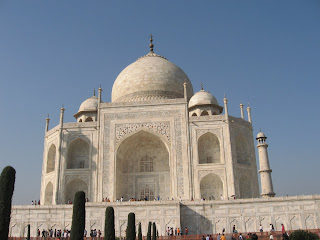From February 4 to 25, 2010, I traveled to India with Toto Tours, a gay men's tour company based in Chicago. There were 14 of us on the South India portion of the tour (through Feb. 20), and 6 on the North India extension (Feb. 20 to 25).
I knew only 2 of my fellow travelers from previous trips with Toto, so part of the adventure was meeting new people, including 4 from Canada and 1 from Australia. My roommate, Jeff Port, was a doctor from Chicago, who happens to be a member of Ohr Chadash, the GLBT synagogue in Chicago whose rabbi (Larry Edwards) is the brother of my rabbi (Lisa Edwards). Small world! There were a total of 4 doctors in the group, which came in handy when some of us got diarrhea. But that didn't stop us from having a great time!
India is the most exotic destination I've traveled to, and the only one I would consider a "Third World" country with a non-Western culture. This of course required some adjustments. We didn't use public restrooms outside hotels or tourist sites, for example, because they usually consist of a hole in the ground which may or may not have a seat. Anyone who thinks the US has a lot of homeless people on the streets should compare it to India, where they are ubiquitous. Beggars and hawkers swarmed around us at every place we went, and we had to learn to say No.
But the poverty we all hear about is only part of the story. Even in smaller towns the stores are well stocked and people seem to have money to buy things. Most people looked reasonably well fed and clothed, except those who live on the streets. Some 90 percent of school age children are enrolled, and they wear uniforms so they are not distinguished by caste or by income level (we saw groups walking to and from school in almost every place we went at the right time of day). They get free lunch in public schools, which is an incentive for parents to send their children rather than keep them working to earn money for the family. There is plenty of industry, including high tech, which is helping to lift the standard of living all over the country. But most of the college students who waited on us in hotel restaurants still want to go the US or UK if they possibly can.
Although the exotic food was part of the adventure, we couldn't eat out much because the local food is not prepared for sensitive Western stomachs. Fresh fruit and veggies are especially problematic because the water is full of bacteria that the locals are accustomed to but we aren't. So we ate mostly in hotel restaurants or other places frequented by Westerners. At each new hotel, the first thing we checked was whether they had left us bottled water so we could take pills and brush our teeth. Most of what we get in the US as "Indian food" is from northern India, where they eat a lot of naan bread, tandoori, basmati rice, etc. Southern Indian food is more spicy, with different curries, tropical fruits (coconut, banana), and more fish.
The weather in southern India was hot and humid, but in the north (Delhi, Agra, and Jaipur) it was about the same as inland California (quite comfortable in February). Delhi is a huge city (about 12 million estimated), and has not built enough roads to handle all the cars that have been added to its traffic in the last decade or so. The traffic jams and smog make LA look like a village. They do have a metro, but it doesn't go to that many parts of the city.
In further posts, I'll include a summary of what we saw, and selected photos (I took over 500 in total).
 Finally, we come to our last stop, Jaipur, known as the "pink city" in the Indian state of Rajasthan. Most of the chief sights in this city date from the 18th and 19th centuries, when a series of maharajas decided to showcase their wealth from mineral deposits and precious stones in the area. First is the Jantar Mantar, an unusual observatory built by a maharaja who was an amateur astronomer. Many of his devices are still accurate today.
Finally, we come to our last stop, Jaipur, known as the "pink city" in the Indian state of Rajasthan. Most of the chief sights in this city date from the 18th and 19th centuries, when a series of maharajas decided to showcase their wealth from mineral deposits and precious stones in the area. First is the Jantar Mantar, an unusual observatory built by a maharaja who was an amateur astronomer. Many of his devices are still accurate today.











































